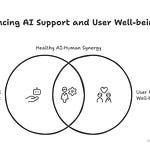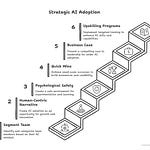The tech world is racing to build fully autonomous AI agents. But what if that’s the wrong goal entirely? Andrej Karpathy just delivered a talk that flips the script on how we should be building the future of AI.
In this deep dive, we’ll break down his most game-changing ideas to help you architect the future. We’ll explore why today’s AI is not a vision of tomorrow, but a direct echo of computing’s past, and what that means for creators and innovators today.
Insights
1. Master “software 3.0” by programming with prompts
The way we build software is undergoing its most significant shift in a generation. We’ve moved from traditional, explicit code (Software 1.0) to the neural network weights of machine learning (Software 2.0). Now, we’re entering a third paradigm: using natural language prompts to instruct LLMs. Karpathy argues this isn’t just a new feature; it’s a new form of programming. As he puts it:
I think we’re seeing... a lot of GitHub code is not just like code anymore there’s a bunch of like English interspersed with code and so I think kind of there’s a growing category of new kind of code.
This elevates prompting from a simple query to a core competency, demanding fluency in all three software paradigms.
2. Treat today’s LLMs as centralized mainframes, not public utilities
It’s tempting to think of LLMs as a ubiquitous utility like electricity, but a more accurate and powerful metaphor is that of a 1960s mainframe computer. They are complex, centralized, expensive, and accessed via “time-sharing on the cloud.” This framing is crucial because it implies that the real “personal computing revolution” for AI, where models become cheap, local, specialized, and user-friendly, hasn’t happened yet.
LLMs are complicated operating systems. They’re circa 1960s in computing and we’re redoing computing all over again.
3. Design around the “amnesiac colleague” problem
Why doesn’t your AI assistant seem to get better over time? Karpathy uses a powerful psychological analogy: current LLMs suffer from a form of “anterograde amnesia.” They can’t consolidate new experiences into lasting expertise. Unlike a human teammate who learns and grows, an LLM starts fresh with every interaction, unable to form persistent knowledge.
If you have a co-worker who joins your organization... they go home and they sleep and they consolidate knowledge and they develop expertise... LLMs don’t natively do this and this is not something that has really been solved.
This highlights a fundamental unsolved challenge.
4. Exploit the “backwards revolution” where consumer apps lead the way
Transformative technologies like GPS and the first computers were born from high-stakes government and military applications. AI has flipped the script. Its first killer app wasn’t in ballistics but in answering everyday questions. Karpathy notes the absurdity and significance of this:
With early computers it was all about ballistics... but with LLMs it’s all about how do you boil an egg... it’s just backwards.
This inverted adoption curve signals that the most fertile ground for innovation is in augmenting individual and consumer life, not just top-down enterprise solutions.
5. Solve for the real bottleneck: the speed of human verification
The dream of fully autonomous agents that “just work” is seductive, but it misses the real bottleneck. The AI can generate code or content at lightning speed, but a human must still audit the output. The true challenge isn’t making the AI faster; it’s making human verification faster.
It’s not useful to me to get a diff of 10,000 lines of code... I”m still the bottleneck... It is in our interest to make this loop go as fast as possible.
The most valuable near-term innovations will be in the user interface of human-AI collaboration.
6. Empower users with an “autonomy slider” for fluid control
Instead of a binary choice between manual work and full automation, the best AI tools offer a spectrum of control. The “autonomy slider” is a powerful mental model for this, allowing a user to decide how much control to cede to the AI based on the task’s complexity. A simple task might be fully automated, while a complex one requires tight human supervision. As Karpathy notes:
You are in charge of the autonomy slider and depending on the complexity of the task at hand you can tune the amount of autonomy that you’re willing to give up for that task.
7. Follow the “Iron Man” rule: build augmenting suits, not autonomous robots
This is perhaps the most tactical advice for anyone building with AI today. Given the fallibility of current models, the goal should be augmentation, not replacement. We need to create tools that make experts better, faster, and smarter, an “Iron Man suit” for the mind. Chasing fully autonomous “Iron Man robots” is a much harder, longer-term challenge. Karpathy advises to focus on…
…less Iron Man robots and more Iron Man suits that you want to build... less like building flashy demos of autonomous agents and more building partial autonomy products.
8. Prepare for the next frontier: an “agent-native” internet
For AI agents to truly become useful, the internet itself must evolve. Today’s web is built for human eyes and hands, with instructions like “click here.” An enormous opportunity lies in creating a parallel, “agent-native” infrastructure with machine-readable commands.
Anytime your docs say click this is bad an LLM will not be able to natively take this action.
He points to Vercel as an example, which is “replacing every occurrence of click with an equivalent curl command.”
9. Use GUIs as a superhighway to the user’s brain
Why are visual interfaces so critical for AI? Because they tap into the human brain’s most powerful processor: our visual cortex. Auditing a massive wall of text is slow and cognitively taxing. Auditing a visual “diff” of changes is fast and intuitive.
A guey utilizes your computer vision GPU in all of our head reading text is effortful... but looking at stuff is fun and it's it's just a kind of like a highway to your brain.
Great design isn’t just aesthetics; it’s the key to an efficient human-AI system.
10. Capitalize on “vibe coding” to empower a new class of creators
The rise of natural language as a programming interface is a seismic shift. The ability to create software is no longer gated by years of learning complex syntax; it’s now accessible to anyone who can describe an outcome. This “vibe coding” is a profound democratization of technology.
Suddenly everyone is a programmer because everyone speaks natural language like English. This is extremely bullish and very interesting to me and also completely unprecedented I would say.
11. Keep the AI on a tight leash with auditable, intermediate steps
For complex, multi-step goals like learning a new subject, giving an LLM a broad, unconstrained prompt is a recipe for failure. A more effective strategy is to keep it “on a leash.” First, have the AI generate an intermediate, auditable artifact, like a course syllabus. Once a human verifies that structure, the AI can execute each part.
I don’t think it just works to go to chat and be like “Hey teach me physics.”... the AI... gets lost in the woods. We now have this intermediate artifact of a course that is auditable.
12. Heed the “self-driving car” lesson: this is a decade-long journey, not an overnight success
The journey of autonomous vehicles offers a sobering but essential lesson. It took over a decade to go from a seemingly “solved” demo to limited real-world deployment. Software is an equally complex and tricky domain. Expectations for fully autonomous agents must be tempered with this reality. As Karpathy warns:
When I see things like oh 2025 is the year of agents I get very concerned and I kind of feel like you know this is the decade of agents and this is going to be quite some time we need humans in the loop.
Takeaways
Adopt the "Iron Man suit" mindset: Re-evaluate your roadmap. Are you trying to replace an expert or supercharge them? Focus your resources on augmentation to deliver value faster.
Audit your UI/UX: Is your product designed for rapid human verification? Identify the slowest parts of your human-in-the-loop cycle and invest in GUI-based solutions that leverage our innate visual processing power.
Implement the "autonomy slider": Give your users granular control. Instead of a single "on/off" switch for AI features, design a fluid interface that allows users to adjust the level of AI assistance based on their confidence and the task’s stakes.
Make your documentation “agent-native”: Start preparing for the future by adding machine-readable commands (like cURL or API calls) alongside human-centric instructions in your documentation. This is a low-cost way to future-proof your product.
Use intermediate artifacts for complex workflows: For any multi-step process, force the AI to “show its work” with a verifiable plan. Don’t let the LLM run unconstrained; use auditable steps (like outlines, syllabi, or project plans) to keep it on track and ensure quality.
The insights from Karpathy’s analysis paint an exhilarating picture of the path forward. We are at the very beginning of a new computing revolution, a moment rich with the same opportunities as the dawn of the mainframe or the personal computer. The potential to build a new generation of tools that amplify human intellect and creativity is immense.
Of course, pioneering this new frontier requires a strategic shift. It means embracing the powerful, yet deeply flawed, nature of the tools we have today. The biggest wins won’t come from chasing the science-fiction dream of perfect, autonomous agents, but from the pragmatic and creative work of designing brilliant human-computer partnerships.
This brings us to the essential challenge to take back to your team: Stop trying to build a pilot that can fly on its own. Instead, commit to designing the world's best co-pilot for your user. That's where the real revolution begins.












Share this post